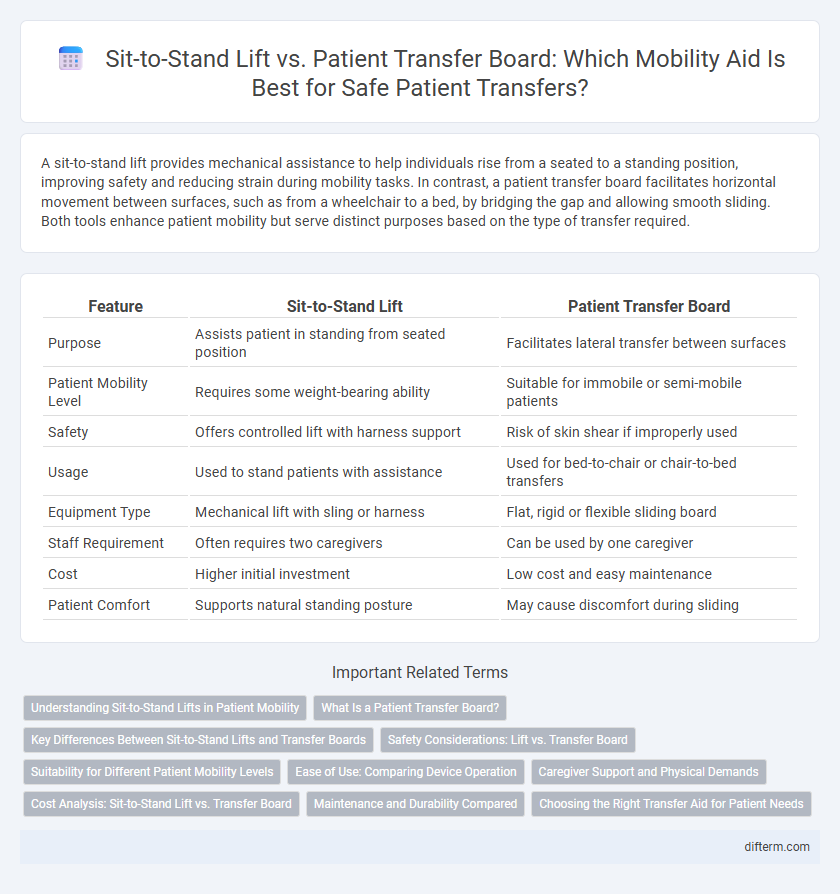A sit-to-stand lift provides mechanical assistance to help individuals rise from a seated to a standing position, improving safety and reducing strain during mobility tasks. In contrast, a patient transfer board facilitates horizontal movement between surfaces, such as from a wheelchair to a bed, by bridging the gap and allowing smooth sliding. Both tools enhance patient mobility but serve distinct purposes based on the type of transfer required.
Table of Comparison
| Feature | Sit-to-Stand Lift | Patient Transfer Board |
|---|---|---|
| Purpose | Assists patient in standing from seated position | Facilitates lateral transfer between surfaces |
| Patient Mobility Level | Requires some weight-bearing ability | Suitable for immobile or semi-mobile patients |
| Safety | Offers controlled lift with harness support | Risk of skin shear if improperly used |
| Usage | Used to stand patients with assistance | Used for bed-to-chair or chair-to-bed transfers |
| Equipment Type | Mechanical lift with sling or harness | Flat, rigid or flexible sliding board |
| Staff Requirement | Often requires two caregivers | Can be used by one caregiver |
| Cost | Higher initial investment | Low cost and easy maintenance |
| Patient Comfort | Supports natural standing posture | May cause discomfort during sliding |
Understanding Sit-to-Stand Lifts in Patient Mobility
Sit-to-stand lifts are designed to assist patients in transitioning from a seated to a standing position, promoting independence and reducing caregiver strain during mobility tasks. These lifts support weight-bearing and enable controlled movements, improving safety compared to patient transfer boards, which primarily facilitate lateral sliding transfers between surfaces. Understanding the biomechanical advantages and appropriate use cases of sit-to-stand lifts enhances mobility outcomes and minimizes the risk of falls or injuries during patient transfers.
What Is a Patient Transfer Board?
A patient transfer board is a smooth, flat device designed to assist in moving individuals with limited mobility between surfaces, such as from a bed to a wheelchair, reducing the risk of injury for both patients and caregivers. It is commonly made from lightweight, durable materials like plastic or wood, facilitating easier sliding over short distances. Patient transfer boards enhance mobility and independence by providing a stable platform during transfers, contrasting with sit-to-stand lifts that assist with vertical lifting motions.
Key Differences Between Sit-to-Stand Lifts and Transfer Boards
Sit-to-stand lifts assist patients in rising from a seated to a standing position using mechanical support, promoting weight-bearing and muscle engagement during transfers. Patient transfer boards enable horizontal sliding transfers between surfaces, minimizing physical effort but requiring some upper body strength and balance. The main differences include the level of patient participation, with sit-to-stand lifts providing active assistance for mobility improvement, while transfer boards offer a passive, low-lift transfer solution primarily for seated or reclined repositioning.
Safety Considerations: Lift vs. Transfer Board
Sit-to-stand lifts provide enhanced safety for patients with limited lower body strength by minimizing fall risk and ensuring stable support during transfers. Patient transfer boards require greater patient cooperation and carry a higher chance of skin shear or pressure injuries if not properly positioned. Choosing between a lift and transfer board depends on individual patient mobility levels and caregiver proficiency to maximize safe transfer outcomes.
Suitability for Different Patient Mobility Levels
Sit-to-stand lifts are ideal for patients with partial weight-bearing ability and some upper body strength, facilitating safe vertical movement while maintaining independence. Patient transfer boards suit individuals with minimal mobility who cannot bear weight but can cooperate in sliding transfers, minimizing caregiver effort and risk of injury. Selecting the appropriate device depends on the patient's mobility level, muscle strength, and balance to ensure safety and comfort during transfers.
Ease of Use: Comparing Device Operation
Sit-to-stand lifts offer automated lifting mechanisms that reduce physical effort and require minimal training, enhancing ease of use for caregivers during patient transfers. Patient transfer boards rely on manual sliding techniques, demanding more physical strength and skill to position safely. The sit-to-stand lift's intuitive controls and ergonomic design provide a more user-friendly operation, especially in fast-paced care environments.
Caregiver Support and Physical Demands
Sit-to-stand lifts significantly reduce physical strain on caregivers by providing mechanical assistance that supports patient weight during transfers, minimizing the risk of musculoskeletal injuries. Patient transfer boards require more manual effort, increasing the likelihood of caregiver fatigue and repetitive strain. Incorporating sit-to-stand lifts enhances caregiver safety and efficiency by reducing the physical demands associated with patient mobility tasks.
Cost Analysis: Sit-to-Stand Lift vs. Transfer Board
Sit-to-stand lifts typically involve higher upfront costs ranging from $1,500 to $3,000 compared to patient transfer boards, which generally cost between $50 and $200. Maintenance and training expenses for lifts can increase overall expenditure, whereas transfer boards require minimal upkeep and training. Considering long-term costs, sit-to-stand lifts may offer improved safety and reduced caregiver strain, potentially lowering indirect costs associated with injuries.
Maintenance and Durability Compared
Sit-to-stand lifts typically require regular mechanical inspections and battery maintenance to ensure consistent functionality and safety, while patient transfer boards demand minimal upkeep, primarily involving routine cleaning to maintain hygiene. Durability-wise, sit-to-stand lifts are constructed from robust steel frames designed to support higher weight capacities over prolonged use, whereas patient transfer boards, often made from lightweight plastic or composite materials, may experience wear or cracking under heavy or frequent load. Selecting between the two depends on the clinical setting's maintenance capacity and long-term reliability requirements.
Choosing the Right Transfer Aid for Patient Needs
Selecting the right transfer aid depends on the patient's mobility level, strength, and specific care requirements. Sit-to-stand lifts provide mechanical support for patients with partial weight-bearing ability, promoting independence during transfers from sitting to standing positions. In contrast, patient transfer boards are more suitable for individuals with limited weight-bearing capacity who need sliding support between surfaces to minimize strain and risk of injury.
sit-to-stand lift vs patient transfer board Infographic

 difterm.com
difterm.com